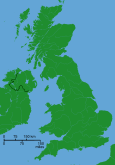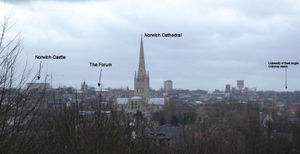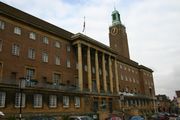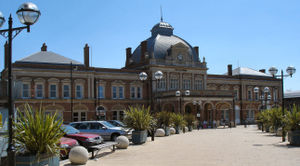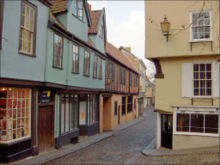Norwich
2007 Schools Wikipedia Selection. Related subjects: Geography of Great Britain
| City of Norwich | ||
|---|---|---|
|
|
 Shown within Norfolk |
|
| Geography | ||
| Status: | City (1195) | |
| Government Region: | East of England | |
| Administrative County: | Norfolk | |
| Area: - Total |
Ranked 322nd 39.02 km² |
|
| Admin. HQ: | Norwich | |
| Grid reference: | TG 232 085 | |
| ONS code: | 33UG | |
| Demographics | ||
| Population: - Total (2005 est.) - Density |
Ranked 149th 127,600 3,270 / km² |
|
| Ethnicity: | 96.8% White | |
| Heraldry | ||
 Arms of the City of Norwich Gules a Castle triple-towered and domed Argent in base a Lion passant guardant Or. |
||
| Politics | ||
| Leadership: | Leader & Cabinet | |
| Executive: | Labour (council NOC) | |
| MPs: | Charles Clarke, Ian Gibson | |
| Post Office and Telephone | ||
| Postcode: | NR | |
| Dialling Code: | 01603 | |
Norwich is a city in East Anglia, in Eastern England, and the regional administrative centre and county town of Norfolk.
The suburban area of the city expands beyond its borough boundary, with large populated areas on most sides, particularly Thorpe St. Andrew on the eastern side. The Parliamentary seats cross over into adjacent local government districts. The population for the Norwich Urban sub-area was 174,047 in 2001. It is the 27th largest settlement in England using this measure. However, the population for the whole built-up area was 194,839 in 2001 (census figures), up 5.1% from the 1991 figure of 185,421. It is the 32nd-largest urban area in England.
History
Roman
The Romans had their regional capital at Venta Icenorum on the river to the south which is now at modern day Caistor St Edmund.
Early English/Norman Conquest
There are two suggested models of development for Norwich. It is possible that three separate early Anglo-Saxon settlements, one on the north of the river and two either side on the south, joined together as they grew or that one Anglo-Saxon settlement, on the north of the river, emerged mid 7th century after the abandonment of the previous three. The ancient city was a thriving centre for trade and commerce in East Anglia in 1004 AD when it was raided and burnt by Swein Forkbeard the Viking. Mersian coins and sherds of pottery from the Rhineland dating to the 8th century suggest that long distance trade was happening long before this. Between 924-939 AD Norwich became fully established as a town due to the fact that it had its own mint. The word Norvic appears on coins across Europe minted during this period, the reign of King Athelstan. The Vikings were a strong cultural influence in Norwich for 40-50 years at the end of the 9th century, setting up an Anglo-Scandinavian district towards the south end of present day King Street.
At the time of the Norman Conquest the city was one of the largest in England. The Domesday Book states that it had approximately twenty-five churches and a population of around 5-10,000. It also records the site of an Anglo-Saxon church in Tombland, the site of the Anglo-Saxon market place and the later Norman cathedral. Norwich continued to be a major centre for trade, the River Wensum being a convenient export route to the sea. Quern stones, and other artifacts, from Scandinavia and the Rhineland have been found during excavations in Norwich city centre which date from the 11th century onwards.
The main area of the city south of the Wensum was destroyed by the construction of the Norman castle (see Norwich Castle) during the 1070s creation of a "New" or "French" borough. During the erection of the castle a new town was built up around it including the market place that is still present today.
In 1096 Bishop Losinga, then Bishop of Thetford, began construction of the cathedral. Limestone was imported from Caen. To get it up to the cathedral site a canal was cut from the river all the way up to the east wall. He then moved his See there to what became the cathedral church for the Diocese of Norwich. The bishop of Norwich still signs himself Norvic.
Middle Ages
By the middle of the 14th century the City Walls, about two and a half miles (4 km) long had been completed. These, along with the river, enclosed a large area, larger than that of the City of London. In the early part of the fifteenth century, Julian of Norwich wrote her famous work.
In 1144, the Jews of Norwich were falsely accused of ritual murder after a boy ( William of Norwich) was found dead with stab wounds. This was the first incidence of blood libel in England. The story was turned into a cult. William acquiring the status of martyr and was subsequently canonized as a saint - this attracted crowds of pilgrims, bringing wealth to the local church. On February 6, 1190, all the Jews of Norwich were massacred except for a few who found refuge in the castle.
The wealth generated by the wool trade throughout the Middle Ages resulted in the construction of many fine churches. Norwich still has one of the highest number of medieval churches in Western Europe. Norwich Market had trading links from Scandinavia to Spain. Around this time, the city was made a county corporate.
The great immigration of 1567 brought a substantial Walloon community of weavers to Norwich. Norwich has been the home of various dissident minorities, notably the French Huguenot and the Belgian Walloon communities in the sixteenth and seventeenth centuries. These immigrants were known locally as 'strangers' (there being a hall in the city called 'Strangers' Hall' for temporary residence, now a museum) and it seems that generally they were accepted as part of the community without animosity. Primarily through trading connections with mainland Europe, ideas of religious reform and radical politics were introduced to Norwich.
English Civil Wars to Victorian Era
The eastern counties were profoundly Parliamentarian in nature and Norwich followed suit, at the cost of some discomfit to the Lord Mayor, a Royalist, and the Bishop Joseph Hall a moderate but targeted because of his position.
The Norwich Canary was first introduced into England by Flemish refugees fleeing from Spanish persecution in the 1500s. They brought with them not only advanced working skills in textiles but also their pet canaries, which they began to breed. The canary is the emblem of the city's football team, Norwich City F.C., nicknamed "The Canaries".
Until the 19th Century, Norwich remained a major provincial capital and, alongside Bristol, was rated closely after London in terms of importance and wealth.
Norwich's geographical isolation was such that until 1845 when a railway connection was established, it was often quicker to travel to Amsterdam by boat than to London. The railway was brought to Norwich by Morton Peto who also built the line onto Great Yarmouth.
From 1808 to 1814 Norwich hosted a station in the shutter telegraph chain which connected the Admiralty in London to its naval ships in the port of Great Yarmouth.
Present day
Culture
The University of East Anglia on the outskirts of Norwich was one of the New Universities founded in 1963, following the Robbins Report. UEA adopted the city's motto of independence Do different and is especially well-known for its creative-writing programme; established by Malcolm Bradbury and Angus Wilson, its graduates include Kazuo Ishiguro and Ian McEwan. The university campus houses the Sainsbury Centre for Visual Arts. The city also has an art college, the Norwich School of Art & Design, located in the centre. Additionally, the Norfolk and Norwich University Hospital on the city's periphery at Colney was opened in 2001.
Norwich Theatre Royal has been on its site for nearly 250 years. The 1300-seat theatre hosts a mix of national touring productions including musicals, dance, drama, family shows, stand-up comedians, opera and pop.
Each year the Norfolk and Norwich Festival celebrates the arts, drawing many visitors into the city from all over the eastern England.
The Forum, designed by Michael Hopkins and Partners and opened in 2002 is a building designed to house the Millennium Library, a replacement for the Norwich Central Library building which burned down in 1994, and the regional headquarters and television centre for BBC East. The building provides a venue for exhibitions, concerts and events, although the city still lacks a dedicated concert venue.
The Millennium Library contains the 2nd Air Division Memorial Library, a collection of material about American culture and the American relationship with East Anglia, especially the role of the United States Air Force on UK air bases throughout the Second World War and Cold War. Much of the collection was lost in the 1994 fire, but the collection has been restored by contributions from many veterans of the war, both European and American.
Recent attempts to shed the backwater image of Norwich and market it as a popular tourist destination, as well as a centre for science, commerce, culture and the arts, have included the refurbishment of the Norwich Castle Museum and the opening of the Forum. The proposed new slogan for Norwich, England's Other City, has been the subject of much discussion and controversy - and it remains to be seen whether it will be finally adopted. A number of signs at the entrance to the city still display the traditional phrase - "Norwich - a fine city."
Business and shopping
The city's economy, originally chiefly industrial with shoemaking a large sector, has changed throughout the eighties and nineties to a service-based economy. Norwich Union, an Aviva company, still dominates these, but has been joined by other insurance and financial services companies.
Norwich Market is an ancient market place, established by the Normans between 1071 and 1074, and is today the largest six days a week open air market in England. The market has recently undergone redevelopment and modernising.
New developments on the former Boulton and Paul site include the Riverside entertainment complex with nightclubs and other venues featuring the usual national leisure brands. Nearby, the football stadium is being upgraded with more residential property development alongside the river Wensum.
Castle Mall, a shopping mall designed by local practice Lambert, Scott & Innes and opened in 1993, presents an ingenious solution to the problem of sensitively creating new retail space in a historic city-centre environment - the building is largely buried underground and in the side of a hill.
The new Chapelfield shopping mall has been built on the site where the Caleys (later Rowntree Mackintosh and Nestlé) chocolate factory once stood. This opened in late September 2005, and is described as 'a major new shopping experience', featuring a new three-floor flagship House of Fraser department store. The new shopping mall, which was the largest to open in Britain in 2005, has been criticised as unnecessary and damaging to local businesses; its presence has prompted smaller retailers to band together to promote the virtues of independent shops.
In August 2006 it was reported by the Javelin Group that Norwich was one of the top five retail destinations in the UK, and in October 2006 the city centre was voted the best in the UK, in a shopping satisfaction survey run by Goldfish Credit Card.
Archant, formerly known as Eastern Counties Newspapers (ECN) is a national publishing group that has grown out of the city's local newspaper, the Norwich Evening News and the regional Eastern Daily Press (EDP).
Norwich has long been associated with the manufacture of mustard. Colman's was founded in 1814 and continues to operate from its factory at Carrow.
Entertainment
Satirical comedian Steve Coogan located his fictional, unbearably vain, cheesy broadcaster ' Alan Partridge' in Norfolk, specifically hosting the pre-breakfast show on the fictional independent station 'Radio Norwich', which since then has been created, although not surprisingly "Up With The Partridge" is not broadcast. It exploited the county's reputation as being somewhat detached from modern trends, past its prime, and rather peripheral to national life.
Other comic entertainers who have drawn comedy from that stereotype include Allan Smethurst ' The Singing Postman' and The Kipper Family lately represented by 'son' Sid Kipper, though these are associated with Norfolk in general and not just the City. These have been joined by The Nimmo Twins.
Independent radio stations include Radio Broadland (formerly Broadland 102), Classic Gold Amber and 99.9 Radio Norwich. BBC Radio Norfolk and the University of East Anglia's Livewire 1350 also broadcast to the city.
A new independent radio station, Radio Norwich, was launched at the end of June 2006, broadcasting on 99.9 FM. There is also a thriving Community Radio station which is soon to begin its permanent tenure on the Norwich airwaves called Future Radio.
Norwich has a thriving music scene based around local venues such as the Norwich Arts Centre and the Marquee. The city is host to many artists that have achieved national and international recognition such as Bearsuit, Cord, Tim Bowness, Sennen, Magoo, KaitO and The Sadtowns. There are also some established record labels in Norwich such as Hungry Audio, Burning Shed, Wilde Club Records and Mummy Where's The Milkman.
Sport
The principal local football team is Norwich City FC, also known as the Canaries (majority-owned by celebrity chef Delia Smith); their ground is at Carrow Road. They have a strong East Anglian rivalry with Ipswich Town FC.
Norwich also has a rugby club, the Norwich Lions.
Perception
Norwich is occasionally portrayed by the media as a city out-of-step with national trends (see Alan Partridge); This is primarily due to its geographic isolation which has contributed greatly to its "unspoilt" and insular character.
Despite this perception, Norwich has a long history of political radicalism and is by no means a conservative city. With 9 seats, Norwich City Council has the largest number of Green Party councillors anywhere in the country. The largest number of seats, however, is held by the Labour Party with 16; the Liberal Democrats are in second place with 12. The Conservative Party is currently in fourth place with only 2 councillors.
In November 2006 the city was voted the greenest in the UK.
According to the 2001 census, 27.8% of respondents in Norwich stated that they were of "no religion", the highest percentage in England.
There has always been a general tolerance of "incomers" by the "native" population of Norwich and Norfolk, though becoming a "local" is still reckoned to take decades. There are good rail links from Norwich railway station to Peterborough and London, and direct services to Cambridge were added in 2004.
A large proportion of the population of Norwich are users of the Internet. A recent article has suggested that, compared with other UK cities, it is top of the league for the percentage of population who use the popular Internet auction site eBay. The city has also unveiled the biggest free Wi-Fi network in the UK, which opened in July 2006.
Geography
Infrastructure
Roads
Norwich is connected to Peterborough via King's Lynn by the A47, the port of Ipswich by the A140, and Cambridge (and the motorway M11 to London) by the A11. Norwich is currently the largest population centre in the UK not to be connected to any other centre by an unbroken dual carriageway.
Rail
Rail links to the rest of the country are via London Liverpool Street Station and Peterborough. Local lines also run to destinations including Great Yarmouth, Lowestoft and Sheringham and Cambridge.
Norwich formerly had three stations running to a number of other local destinations, but now the rail terminus is at Thorpe Station.
Air
Norwich International Airport is a feeder to KLM's Schiphol hub. FlyBe, Air SouthWest, Eastern Airways, and Bristow Helicopters all serve Norwich, in addition to a strong holiday charter flight business. The airport was originally the RAF airfield at Horsham St Faith. This was once the home of Air UK, which grew out of Air Anglia and was then absorbed by the Dutch airline KLM.
Water
The River Yare is navigable from the sea at Great Yarmouth all the way to Trowse, south of the city. From there the River Wensum is navigable into Norwich.
Bridges
- Novi Sad Friendship Bridge
Tourism
Norwich is a popular destination for a city break; major attractions include Norwich Cathedral, the cobbled streets and museums of old Norwich, a Norman Castle and the ultra modern Forum. Norwich is also one of the Uk's top ten shopping destinations, with a mix of high street names, individual shops and one of the largest outdoor markets in England.
Travellers' comments
In 1507 the poet John Skelton ( 1460- 1529) wrote of two destructive fires in his Lament for the City of Norwich.
- All life is brief, and frail all man's estate. City, farewell: I mourn thy cruel fate.
Thomas Fuller in his The Worthies of England described the City in 1662 as -
- Either a city in an orchard or an orchard in a city, so equally are houses and trees blended in it, so that the pleasure of the country and the populousness of the city meet here together. Yet in this mixture, the inhabitants participate nothing of the rusticalness of the one, but altogether the urbanity and civility of the other.
Celia Fiennes ( 1662- 1741) visited Norwich in 1698 and described it as
- a city walled full round of towers, except on the river side which serves as a wall; they seem the best in repair of any walled city I know.
She also records that held in the City three times a year were-
- great fairs...to which resort a vast concourse of people and wares a full trade.
Norwich being a rich, thriving industrious place full of weaving, knitting and dyeing.
Daniel Defoe in his Tour of the whole Island of Great Britain (1724) wrote of the City-
- the inhabitants being all busy at their manufactures, dwell in their garrets at their looms, in their combing-shops, so they all them, twisting-mills, and other work-houses; almost all the works they are employed in being done within doors.
John Evelyn ( 1620- 1706) Royalist, Traveller and Diarist wrote to Sir Thomas Browne-
- I hear Norwich is a place very much addicted to the flowery part.
He visited the City as a courtier to King Charles II in 1671 and described it thus -
- The suburbs are large, the prospect sweet, and other amenities, not omitting the flower-garden, which all the Inhabitants excel in of this City, the fabric of stuffs, which affords the Merchants, and brings a vast trade to this populous Town.
George Borrow in his semi-autobiographical novel Lavengro (1851) wrote of Norwich as-
- A fine old city, perhaps the most curious specimen at present extant of the genuine old English Town. ..Thre it spreads from north to south, with its venerable houses, its numerous gardens, its thrice twelve churches, its mighty mound....There is an old grey castle on top of that mighty mound: and yonder rising three hundred feet above the soil, from amongst those noble forest trees, behold that old Norman master-work, that cloud-enriched cathedral spire ...Now who can wonder that the children of that fine old city are proud, and offer up prayers for her prosperity?
Borrow wrote far less favourably of the City in his translation of Faust-
- They found the people of the place modelled after so unsightly a pattern, with such ugly figures and flat features that the devil owned he had never seen them equalled, except by the inhabitants of an English town, called Norwich, when dressed in their Sunday's best.
In 1812, Andrew Robertson wrote to the painter Constable-
- I arrived here a week ago and find it a place where the arts are very much cultivated....some branches of knowledge, chemistry, botany, etc. are carried to a great length. General literature seems to be pursued with an ardour which is astonishing when we consider that it does not contain a university, as is merely a manufacturing town.
Famous names associated with the city
Throughout its history, Norwich has been associated with radical politics, nonconformist religion, political dissent and liberalism. Between 1790 and 1840, many of the famous names associated with the City flourished. These include:
- Elizabeth Bentley.{ 1763- 1839}.Authoress wrote " Tales for Children in Verse".Lived at 45 St St.Stephen's Square.
- George Borrow ( 1803- 1881), writer and traveller. In his youth Borrow was resident at Willow Lane. He attended the Norwich King Edward school. Borrow recollects his youth in the city and conversations with the philologist and translator of German Romantic literature, William Taylor in his semi-autobiographical novel Lavengro.
- Sir Thomas Browne ( 1605- 1682). medical doctor, polymath scholar, encyclopedist and philosopher with interests in Biblical scholarship and the esoteric. The stylistic purity and stupendous learning displayed in Browne's varied prose in the spheres of religion, science and art are minor classics of World literature.
- Edith Cavell ( 1865- 1915) was born in Swardeston, 4 miles south of Norwich. She was a World War I nurse who was executed by firing squad by the Germans for helping allied prisoners escape in violation of military law. She is buried on Life's Green, on the east side of Norwich Cathedral.
- John Crome and Joseph Stannard, along with John Sell Cotman, established the first art movement outside of London. The Norwich school of painters were influenced by the achievements of Dutch landscape painting and the beauty of the rural hinterland surrounding Norwich.
- William Crotch ( 1775- 1847). Composer, artist and teacher. Norwich's Mozart. He gave daily public organ recitals aged two and a half. Crotch played God Save the King before the King aged three. He had performed at every major town in England and Scotland by the age of seven. Crotch became Organist of Christ Church, Oxford and for fifty years he was Oxford's Professor of Music. Unlike Mozart, however, his precocious musical talents failed to mature to genius.
- Pablo Fanque ( 1796 - 1871). The first Black Circus Proprietor in Britain was born in the city.
- Elizabeth Fry ( 1780- 1845). The prison reformer and leading Quaker was born in Gurney Court in Magdalen Street and was one of several philanthropists associated with the city. Her portrait is upon the Series E (2005) Bank of England £5 note.
- Joseph John Gurney ( 1788- 1847) was a banker and philanthropist who worked with his sister Elizabeth Fry (see above) in prison reform. He was also active in the movement to abolish the slave trade and a member of the temperance movement.
- Robert William Bilton Hornby ( 1821- 1884) was a noted local antiquarian, priest and lord of the manor from the City of York. He was ordained a deacon at Norwich in 1844.
- Julian of Norwich. Medieval Christian mystic and contemporary of Chaucer. Julian is the author of The revelations of Divine Love the first book written by a woman in the English language. Julian's writings are well-represented by the scholarly website www.umilta.net.
- Robert Kett. Norwich's very own Robin Hood or Wat Tyler. Kett was a Norfolk landowner from Wymondham who lead the peasant's revolt in 1549 in the name of the common man against the corrupt Norfolk landowners. This eventually lead to the Battle of Dussindale against the King's forces on the 27th August 1549 in which 3000 of Kett's men were killed. He was hanged for Treason at Norwich Castle on the 7th December 1549.
- James Martineau ( 1805 - 1900) Philosopher and brother to Harriet.
- Harriet Martineau ( 1802- 1876). The daughter of a Norwich manufacturer of Huguenot descent, she suffered from ill-health and deafness throughout her life. A devout Unitarian, her writings include Illustrations of political economy (1832-1834). Harriet Martineau supported the abolitionist campaign in the United States writing Society in America (1837). She translated writings by Auguste Comte. Her first novel was entitled Deerbrook ( 1839). A radical in religion she published the anti-theological Laws of Man's Social Nature ( 1851) and Biographical sketches ( 1869).
- Admiral Horatio Nelson attended the Norwich School from 1767 to 1768. He was born in nearby Burnham Thorpe.
- Amelia Opie ( 1769- 1853), Norwich author and Quaker. In 1825 she drastically changed her life as a socialite, party-goer, and attendant at literary soirees, to become a Quaker.
- Sir James Edward Smith botanist, natural historian and one-time owner of the Linnean collection of Carolus Linnaeus
- William Smith ( 1756 – 1835), Whig politician, dissenter and abolitionist, M.P. for Norwich from 1807.
Contemporary names associated with Norwich
- Bill Bryson, American writer and humorist, lives near Wymondham, near Norwich.
- Cathy Dennis, famous Singer/ Songwriter who was born in Norwich in 1969.
- Ralph Firman, former Formula 1 Driver was born in Norwich in 1975. He and his family live in nearby Attleborough, and he was educated at Gresham's School. Currently racing in the A1 Grand Prix series for Ireland, for which he qualifies through his Mother's Irish nationality.
- Stephen Fry, comedian, author, actor and filmmaker, studied at Norwich City College, and is a Norwich City F.C. fan.
- Trisha Goddard, talk show host lives in Norwich.
- Andy Green OBE, a Wing Commander in the Royal Air Force, is the current holder of the world land speed record, having piloted the ThrustSSC to the first ever supersonic speed on land in the Black Rock Desert, USA on 25 September 1997.
- Paul Jones, blues singer and BBC Radio 2 presenter.
- Becky Mantin, ITV Weather presenter and This Morning reporter.
- Bernard Matthews, founder of the eponymous meat company.
- Sir John Mills, born in North Elmham in Norfolk. Mills was educated at the Norwich High School for Boys. He also had Football (Soccer) trials with Norwich City F.C. in the 1920s before moving into acting.
- Beth Orton, Award-winning singer/songwriter, was born in Dereham and spent much of her childhood in Norwich.
- Philip Pullman, British writer was born in Norwich on 19 October 1946. Best-selling author of the His Dark Materials trilogy of fantasy novels and a number of other books.
- Delia Smith, majority shareholder of Norwich City Football Club (note: she was born in Surrey and lives in Suffolk). The television cook who taught us all how to boil eggs to perfection, and make toast that isn't "sweaty" (i.e. place it in a toast rack - don't lie it down), has been a favourite of the city ever since she arrived, helping save the club from going into administration.
- Chris Sutton, Football player (striker); joint top scorer for the Premier League in 1997/8; formerly the record English transfer (at £5 million from Norwich to Blackburn in 1994).
- Tim Westwood, BBC Radio 1 Rap DJ and presenter of popular MTV show "Pimp My Ride (UK)". Grew up in and around Norwich (his father was the bishop of Peterborough, in the neighbouring county of Cambridgeshire) and went to Norwich School.
Architecture
Norwich is considered to have a wealth of historical architecture. The medieval period is represented by the 11th-century Norwich Cathedral, 12th-century castle (now a museum) and a large number of parish churches. During the Middle Ages, 57 churches stood within the city wall; 31 still exist today. This gave rise to the common (in the city) saying that it had a church for every week of the year, and a pub for every day. Most of the medieval building is in the city centre. From the 18th century the pre-eminent local name is Thomas Ivory, who built the Assembly Rooms (1776), the Octagon Chapel (1756), St Helen's House (1752) in the grounds of the Great Hospital, and innovative speculative housing in Surrey Street (c. 1761). Ivory should not be confused with the Irish architect of the same name and similar period.
The 19th century saw an explosion in Norwich's size and much of its housing stock, as well as commercial building in the city centre, dates from this period. The local architect of the Victorian and Edwardian periods who has continued to command most critical respect was George Skipper (1856-1948). Examples of his work include the headquarters of Norwich Union on Surrey Street; the Art Nouveau Royal Arcade; and the Hotel de Paris in the nearby seaside town of Cromer. The neo-Gothic Roman Catholic cathedral on Earlham Road, begun in 1882, is by George Gilbert Scott Junior and his brother, John Oldrid Scott.
The city continued to grow through the 20th century and much housing, particularly in areas further out from the city centre, dates from that century. The first notable building post-Skipper was the city hall by CH James and SR Pierce, opened in 1938. Bombing during the Second World War, while resulting in relatively little loss of life, caused significant damage to housing stock in the city centre. Much of the replacement postwar stock was designed by the local authority architect, David Percival. However, the major postwar development in Norwich from an architectural point of view was the opening of the University of East Anglia in 1964. Originally designed by Denys Lasdun (his design was never completely executed), it has been added to over subsequent decades by major names such as Norman Foster and Rick Mather.
Twinned cities
The city is twinned with the following cities:
